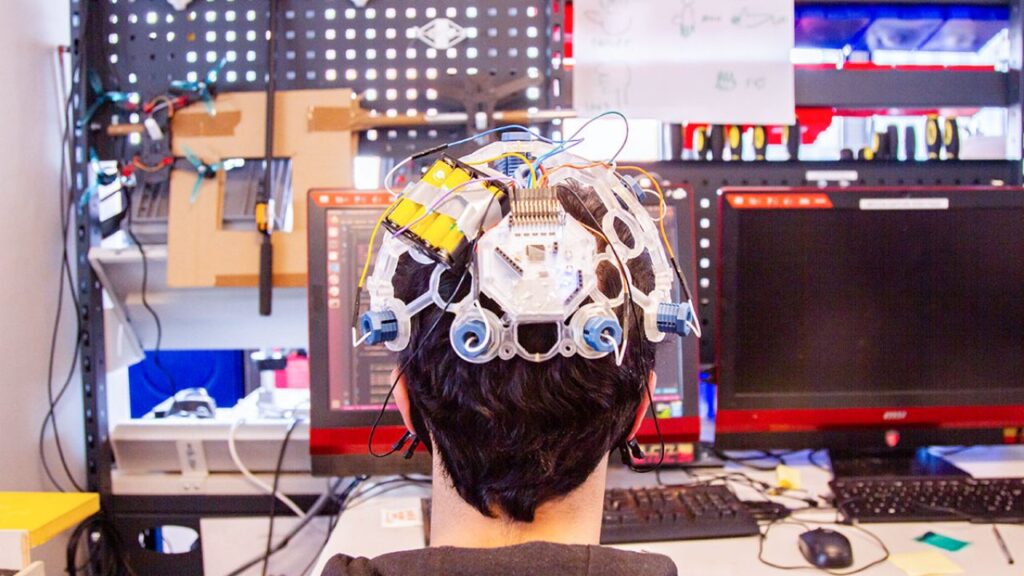Brain-Computer Interfaces: Unlocking Humanity’s Astonishing Future
Introduction
Imagine controlling a robotic arm with just your thoughts, communicating without speaking, or even experiencing virtual worlds directly through your mind. These aren’t just concepts from science fiction; they are the burgeoning realities being shaped by Brain-Computer Interfaces (BCIs). At its core, a BCI is a direct communication pathway between an enhanced or wired brain and an external device, allowing thoughts and intentions to bypass the body’s natural output pathways (like muscles) and directly control technology. Once confined to laboratories and speculative fiction, BCIs are rapidly advancing, promising revolutionary changes in medicine, human augmentation, and our very definition of interaction. This comprehensive article will delve into the fascinating world of BCIs, exploring their fundamental mechanisms, their current and future applications, the formidable technical and ethical challenges they pose, and the profound implications they hold for humanity’s future.
Decoding Thought: How Brain-Computer Interfaces Work
To truly appreciate Brain-Computer Interfaces, it’s crucial to understand how they translate neural activity into commands. The fundamental principle behind BCIs involves reading brain activity, interpreting it, and translating it into signals for an external device.
A prime example of this progress is the work of companies like Neuralink https://neuralink.com which is developing advanced brain implants aimed at directly connecting the human brain to computers.
This process typically involves several key stages:
1. Brain Signal Acquisition
This is where the brain’s electrical activity is detected. The methods vary significantly based on whether the BCI is invasive or non-invasive:
- Non-Invasive BCIs: These devices are worn outside the head and do not require surgery.
- Electroencephalography (EEG): The most common non-invasive method. Electrodes placed on the scalp detect electrical activity from groups of neurons. EEG is relatively inexpensive and portable, though it has lower spatial resolution.
- Functional Near-Infrared Spectroscopy (fNIRS): Uses infrared light to measure changes in blood oxygenation related to brain activity.
- Invasive BCIs: These require surgical implantation of electrodes directly into the brain.
- Electrocorticography (ECoG): Electrodes are placed on the surface of the brain, beneath the skull. This offers better signal quality than EEG but is less invasive than direct brain implants.
- Intracortical Arrays: Tiny electrode arrays (like Neuralink’s “threads” or Utah Array) are implanted directly into the brain tissue, typically in specific motor or sensory cortices. These provide the highest signal resolution and bandwidth, allowing for very precise control and potentially even sensory feedback.
2. Signal Processing
Once brain signals are acquired, they are amplified, filtered to remove noise, and digitized. Advanced signal processing techniques are then used to extract meaningful patterns related to specific thoughts or intentions. This step is crucial for the effectiveness of any Brain-Computer Interface.
3. Feature Extraction and Translation
This is the crucial step where algorithms identify specific “features” within the processed brain signals (e.g., changes in frequency bands, amplitude spikes) that correspond to a desired action or thought. Machine learning models are then trained to translate these neural patterns into commands for the external device. For example, a specific pattern might be translated into “move cursor left” or “select option A.” This translation is key to the functionality of BCIs.
4. Device Output
The translated commands are then sent to the external device, which executes the desired action. This could be moving a robotic limb, typing on a screen, controlling a drone, or even stimulating specific brain regions.
5. Feedback (Optional but Crucial)
For many applications, especially those involving motor control or prosthetics, feedback is vital. This allows the user to see, feel, or hear the result of their brain command, enabling them to refine their control over time, much like how we learn to ride a bicycle. Effective feedback enhances the user’s ability to operate the BCI.
Transformative Applications: Where BCIs Are Reshaping Lives and Futures
The potential applications of Brain-Computer Interfaces span across medicine, human augmentation, and beyond, demonstrating the vast impact of BCIs.
1. Medical Rehabilitation and Assistive Technologies
This is where BCIs are currently making the most significant impact, offering new hope for individuals with severe neurological conditions or paralysis:
- Restoring Movement: BCIs enable individuals with paralysis (due to spinal cord injury, stroke, ALS, etc.) to control prosthetic limbs, robotic exoskeletons, or even their own paralyzed limbs (via functional electrical stimulation) using only their thoughts.
- Communication for “Locked-in” Patients: For patients unable to move or speak (e.g., those with advanced ALS), BCIs can provide a vital communication channel, allowing them to type messages, select options, or control a computer cursor with their brain activity.
- Controlling External Devices: Patients can operate wheelchairs, smart home devices, or even navigate the internet using their thoughts, all thanks to Brain-Computer Interfaces.
- Neurological Disorder Management: BCIs are being explored for applications like deep brain stimulation for Parkinson’s disease or seizure prediction and prevention for epilepsy, offering more targeted and responsive therapies.
2. Human Augmentation and Cognitive Enhancement
Beyond addressing medical conditions, BCIs hold the potential to enhance human capabilities, moving into the realm of “cyborgs”:
- Enhanced Sensory Perception: Potentially enabling humans to perceive new types of information (e.g., infrared light) or augment existing senses through BCI technology.
- Improved Memory: While highly speculative, some research explores using BCIs to bolster memory formation or retrieval.
- Cognitive Augmentation: Potentially improving focus, learning speed, or even facilitating direct knowledge transfer. This is a very long-term and ethically complex goal for Brain-Computer Interfaces.
- Direct Brain-to-Brain Communication: While still largely theoretical, the idea of directly transmitting thoughts or experiences between brains via BCI technology is a fascinating, if daunting, prospect.
3. Gaming and Virtual Reality
The gaming industry is keen on BCIs for more immersive and intuitive control:
- Mind-Controlled Gaming: Imagine controlling characters or executing actions in a game purely with your thoughts, offering a level of immersion impossible with traditional controllers.
- Enhanced VR/AR Experiences: BCIs could deepen immersion in virtual and augmented realities by providing direct neural input and potentially even sensory feedback.
4. Military and Defense Applications
BCIs have clear implications for military applications, including:
- Controlling Drones and Robotics: Soldiers could potentially control drones or advanced weaponry with their thoughts, improving reaction times and reducing cognitive load with the help of Brain-Computer Interfaces.
- Enhanced Situational Awareness: Directly integrating battlefield data into a soldier’s perception.
The Road Ahead: Formidable Challenges for BCI Development
Despite the astounding progress, BCIs face significant technical, medical, and ethical hurdles that must be overcome for widespread adoption.
1. Technical Challenges
- Signal Quality and Reliability: Maintaining stable, high-resolution brain signals over long periods, especially for non-invasive systems, is difficult due to noise and signal degradation. Invasive implants face issues like biocompatibility (the brain’s reaction to the implant) and signal degradation over time due to scar tissue formation. This remains a key challenge for BCIs.
- Bandwidth and Latency: For complex control, BCIs need high bandwidth (lots of data transfer) and low latency (minimal delay between thought and action). Achieving this reliably, especially wirelessly, is a major engineering challenge for Brain-Computer Interfaces.
- Portability and Power: Making BCIs small, discreet, and energy-efficient for everyday use is crucial.
- Machine Learning Complexity: Training robust and adaptive algorithms that can accurately interpret individual brain signals and adapt to changes over time is computationally intensive and complex.
2. Medical and Surgical Risks (for Invasive BCIs)
- Surgical Risks: Any invasive surgery carries risks like infection, bleeding, and brain damage.
- Long-Term Safety: The long-term effects of having implants in the brain, including potential inflammation, immune response, and mechanical degradation, are still being studied for invasive BCIs.
- Battery Life and Maintenance: Invasive devices require power sources, which often mean additional procedures for battery replacement.
3. Ethical and Societal Concerns (Your Expertise is Paramount!)
This is where the discussion surrounding Brain-Computer Interfaces becomes critical and touches upon your cybersecurity background.
- Privacy of Thought and Data Security: Brain signals contain deeply personal and sensitive information. How will this data be protected from hacking, misuse, or commercial exploitation? The prospect of companies having access to or being able to decipher thoughts raises profound privacy concerns. This is a massive cybersecurity challenge: securing neural data from interception, tampering, or unauthorized access is paramount for all BCIs.
- Identity and Agency: If external devices can directly influence brain activity or vice versa, what does this mean for individual autonomy and the very definition of identity? Could BCIs be manipulated to alter thoughts or behaviors?
- Equity and Access: Will BCIs be accessible only to the wealthy, creating a new “cognitive divide” where some individuals have enhanced abilities while others do not?
- Regulation and Governance: As Brain-Computer Interfaces advance, clear legal and ethical frameworks will be needed to govern their development, deployment, and use, addressing issues of responsibility, liability, and consent.
- Psychological Impact: The long-term psychological effects of direct brain-computer interaction, including potential dependency or changes in self-perception, are still unknown.
The Future of BCIs: A Synergistic Evolution
Despite the challenges, the future of Brain-Computer Interfaces is incredibly promising, driven by rapid advancements in neuroscience, AI, and miniaturization.
- Smarter Algorithms and AI Integration: AI will become even more sophisticated at decoding complex brain signals, leading to more intuitive and seamless control. Generative AI could even play a role in creating new neural pathways or interpreting previously unreadable signals for BCIs.
- Miniaturization and Wireless Power: Implants will become smaller, less invasive, and potentially powered wirelessly, reducing surgical burden and improving user comfort.
- Enhanced Sensory Feedback: Providing users with more realistic and nuanced sensory feedback (e.g., feeling textures through a prosthetic hand) will greatly improve the utility of BCIs.
- Hybrid BCIs: Combining different types of BCI technologies (e.g., non-invasive for daily use, invasive for specific, high-precision tasks) could offer optimized solutions.
- From Therapy to Augmentation: While medical applications will remain a primary focus, research will increasingly explore non-medical applications of BCIs, potentially leading to widespread use for healthy individuals seeking cognitive enhancements or new forms of interaction.
- Ethical Frameworks Keeping Pace: As the technology evolves, so too must the public discourse and regulatory efforts to ensure BCIs are developed and used responsibly, upholding human rights and dignity.
Conclusion
Brain-Computer Interfaces stand at the threshold of a profound technological revolution, promising to redefine the relationship between the human mind and the digital world. From restoring lost senses and mobility to unlocking unprecedented forms of communication and potentially even cognitive enhancement, the transformative power of BCIs is immense. However, this promising future is intertwined with significant technical hurdles and, more critically, complex ethical and societal dilemmas, particularly concerning privacy, security, and human identity. As engineers, scientists, and policymakers continue to push the boundaries of this incredible field, ensuring responsible innovation and prioritizing human well-being will be paramount. The journey into connecting minds with machines has just begun, and its trajectory will undoubtedly shape the very essence of human potential in the decades to come.
© 2025 upcorehub.com. All rights reserved.


